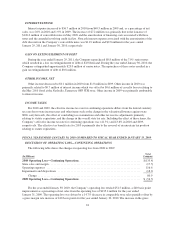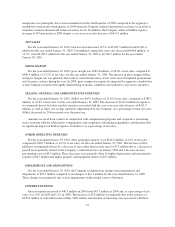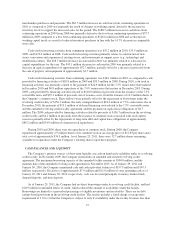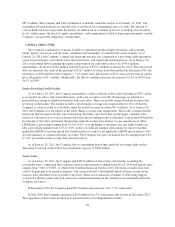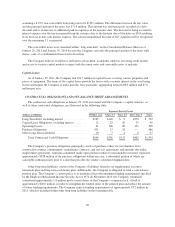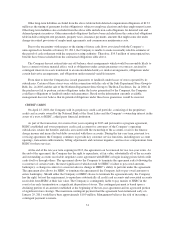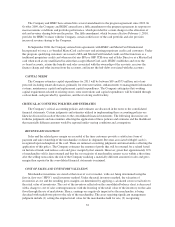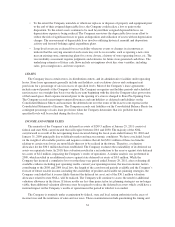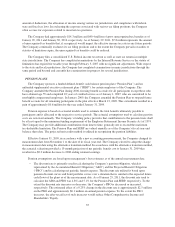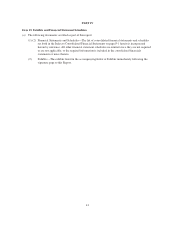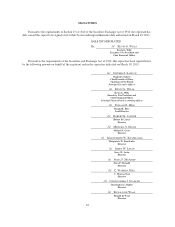Saks Fifth Avenue 2010 Annual Report Download - page 34
Download and view the complete annual report
Please find page 34 of the 2010 Saks Fifth Avenue annual report below. You can navigate through the pages in the report by either clicking on the pages listed below, or by using the keyword search tool below to find specific information within the annual report.merchandise for which the customer’s perception of value has declined and appropriately marking the retail
value of the merchandise down to the perceived value, and (3) estimating the shrinkage that has occurred through
theft during the period between physical inventory counts.
These judgments and estimates, coupled with the averaging processes within the retail method, can, under
certain circumstances, produce varying financial results. Factors that can lead to different financial results
include setting original retail prices for merchandise held for sale too high, failure to identify a decline in
perceived value of inventories and process the appropriate retail value markdowns, and overly optimistic or
overly conservative inventory shrinkage estimates. The Company believes it has the appropriate merchandise
valuation and pricing controls in place to minimize the risk that its inventory values would be materially under or
overvalued.
The Company regularly records a provision for estimated shrinkage, thereby reducing the carrying value of
merchandise inventory. A complete physical inventory of all the Company’s stores and distribution facilities is
performed annually, with the recorded amount of merchandise inventory being adjusted to coincide with this
physical count. The differences between the estimated amount of shrinkage and the actual amount realized have
been insignificant.
The Company receives vendor provided support in different forms. When the vendor provides support for
inventory markdowns, the Company records the support as a reduction to cost of sales. Such support is recorded
in the period that the corresponding markdowns are taken. When the Company receives inventory-related support
that is not designated for markdowns, the Company includes this support as a reduction in cost purchases.
SELF-INSURANCE RESERVES
The Company self-insures a substantial portion of its exposure for costs related primarily to employee
medical, workers’ compensation and general liability. Expenses are recorded based on estimates for reported and
incurred but not reported claims considering a number of factors, including historical claims experience, severity
factors, litigation costs, inflation and other assumptions. Although the Company does not expect the amount it
will ultimately pay to differ significantly from its estimates, self-insurance reserves could be affected if future
claims experience differs significantly from the historical trends and assumptions.
DEPRECIATION AND RECOVERABILITY OF CAPITAL ASSETS
Over forty percent of the Company’s assets at January 29, 2011 are represented by investments in property
and equipment. Determining appropriate depreciable lives and reasonable assumptions for use in evaluating the
carrying value of capital assets requires judgments and estimates.
• Depreciation is computed using the straight-line method over the estimated useful lives of the assets.
Land is not depreciated. Buildings and building improvements are depreciated over 20 to 40 years.
Store fixtures are depreciated over 10 years. Equipment utilized in stores (e.g., escalators) and in
support areas (e.g., distribution centers, technology) and fixtures in support areas are depreciated over 3
to 10 years. Leasehold improvements are amortized over the shorter of their estimated useful lives or
their related lease terms, generally ranging from 10 to 20 years. Internally generated computer software
is amortized over 3 to 7 years. Generally, there is no estimated salvage value at the end of the useful
life of the assets.
• Costs incurred when constructing stores, including interest expense, are capitalized. The Company may
receive allowances from landlords related to the construction. If the landlord is determined to be the
primary beneficiary of the property, then the portion of those allowances attributable to the property
owned by the landlord is considered to be a deferred rent liability, whereas the corresponding capital
expenditures related to that store are considered to be prepaid rent. Allowances in excess of the
amounts attributable to the property owned by the landlord are considered improvement allowances
and are recorded as deferred rent liabilities that are amortized over the life of the lease. Capital
expenditures are also reduced when the Company receives cash and allowances from merchandise
vendors to fund the construction of vendor shops.
33



